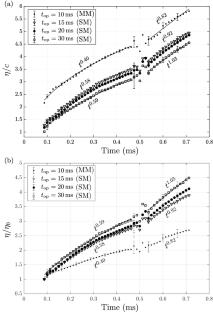Time-resolved schlieren photography was used to visualise mixing zones induced by the Richtmyer–Meshkov instability. These were initiated with four different initial conditions: three of them with monotonic, single-mode shapes and one with a non-monotonic, multi-mode shape. These initial conditions were generated by an innovative experimental concept, the Micro Rotating Shutter System. The results of this experimental campaign reveal that the shape of the initial air–helium interface influences the subsequent development of the resulting mixing zone. Over the measurement time range, the width of the mixing zone induced by this instability is correctly fitted by a power law. Its growth exponent depends on the monotonicity of the initial air–helium interface: while mixing widths originating from single-mode initial conditions are almost superimposed, a lesser growth exponent is found for the multi-mode initial condition. The Reynolds number based on the width of the mixing zone suggests that both flows initiated with single- and multi-mode initial conditions reach a fully turbulent state after the interaction with the reflected shock wave (reshock). The schlieren photography visualisations presented here also allow to illustrate the structure of the induced mixing and highlight the effect of the initial conditions on the large-scale structures of the Richtmyer–Meshkov instability-induced mixing.



